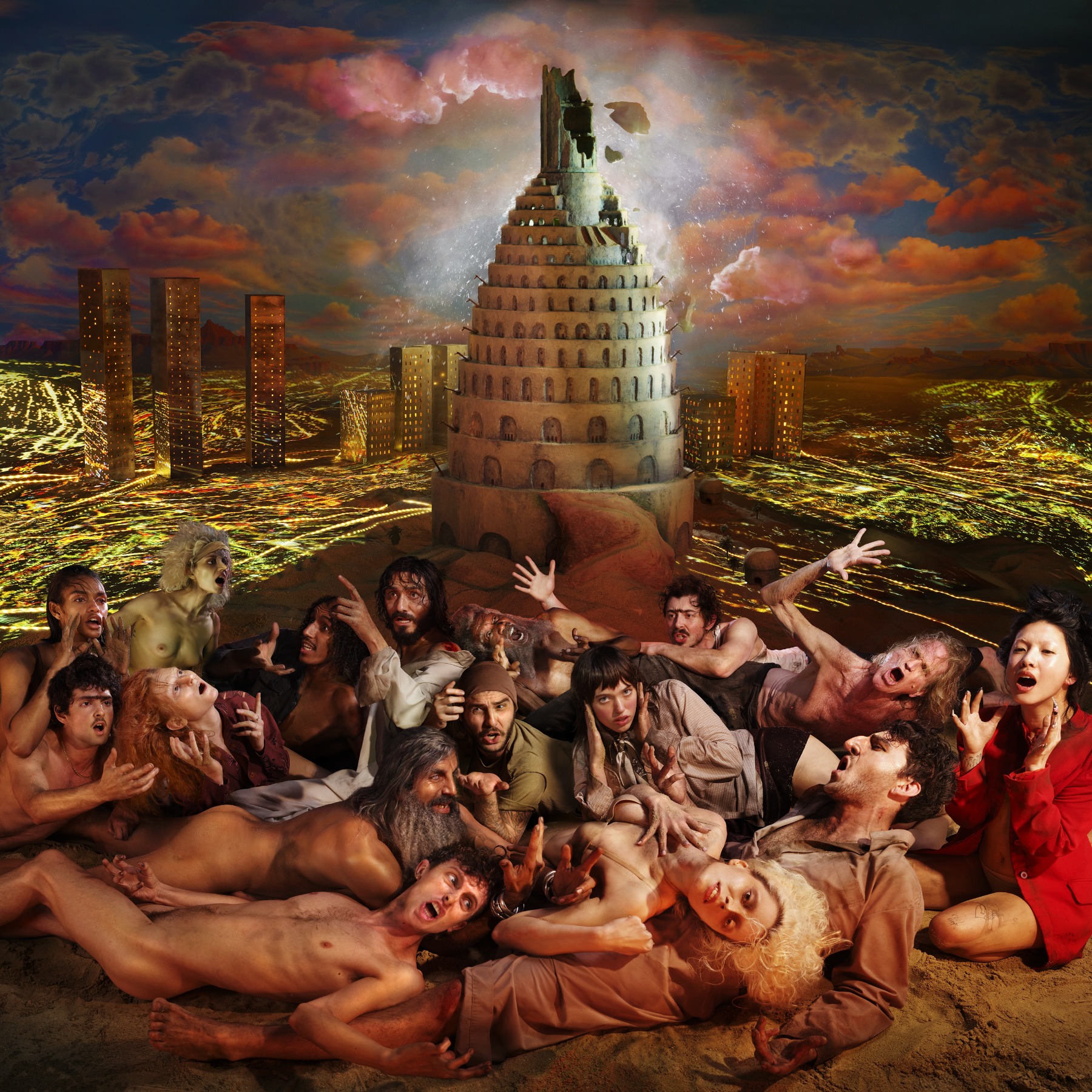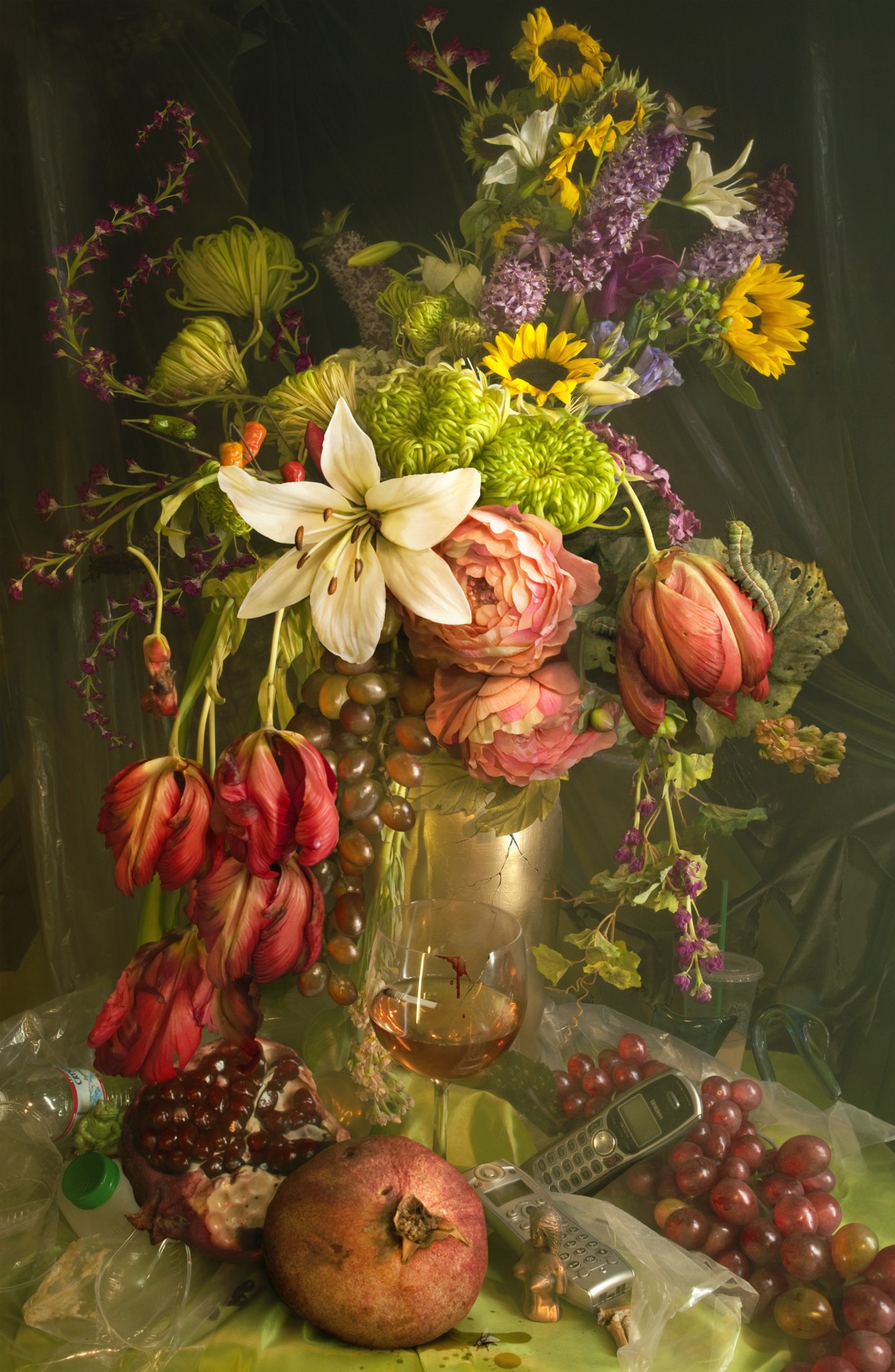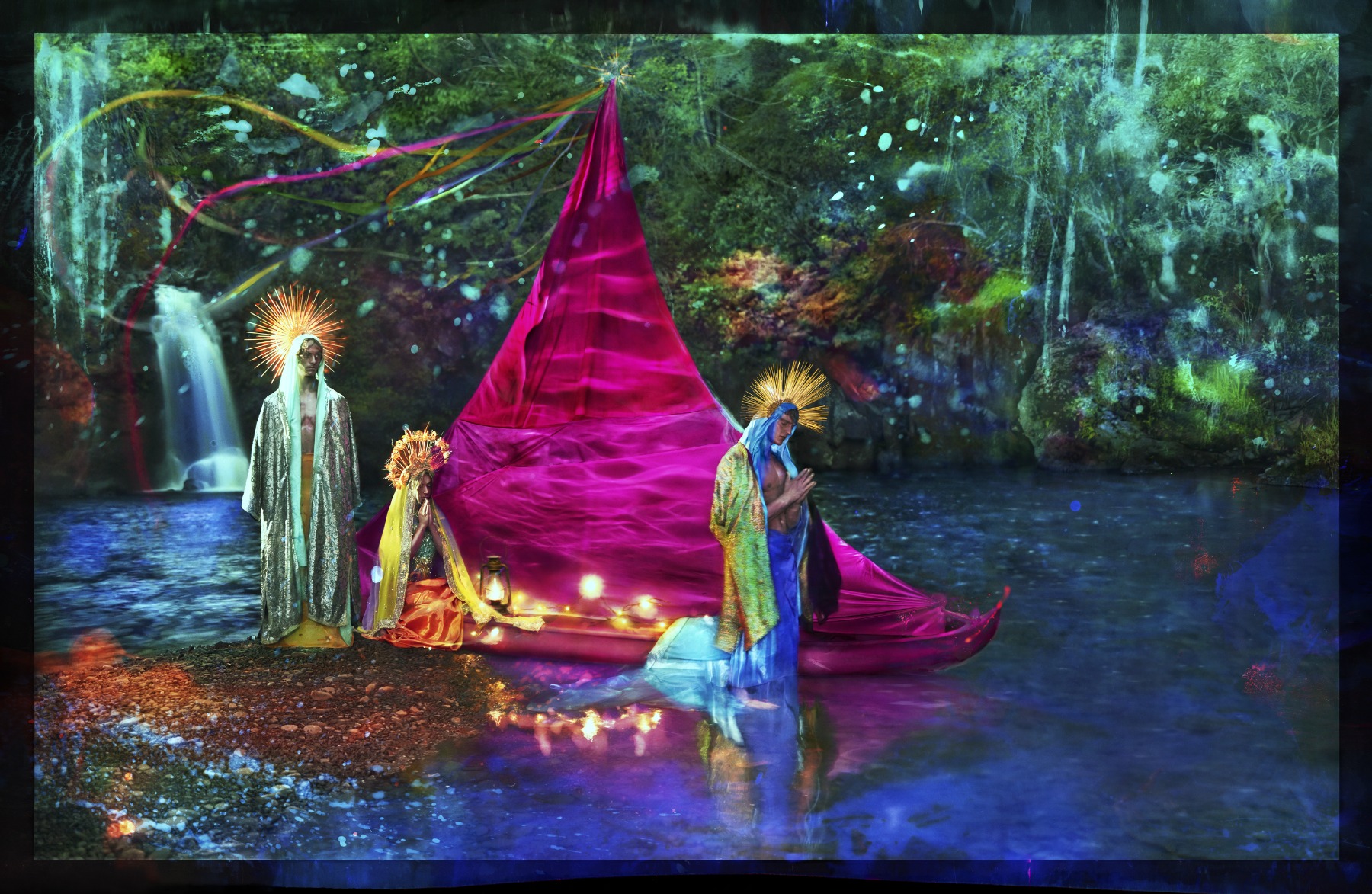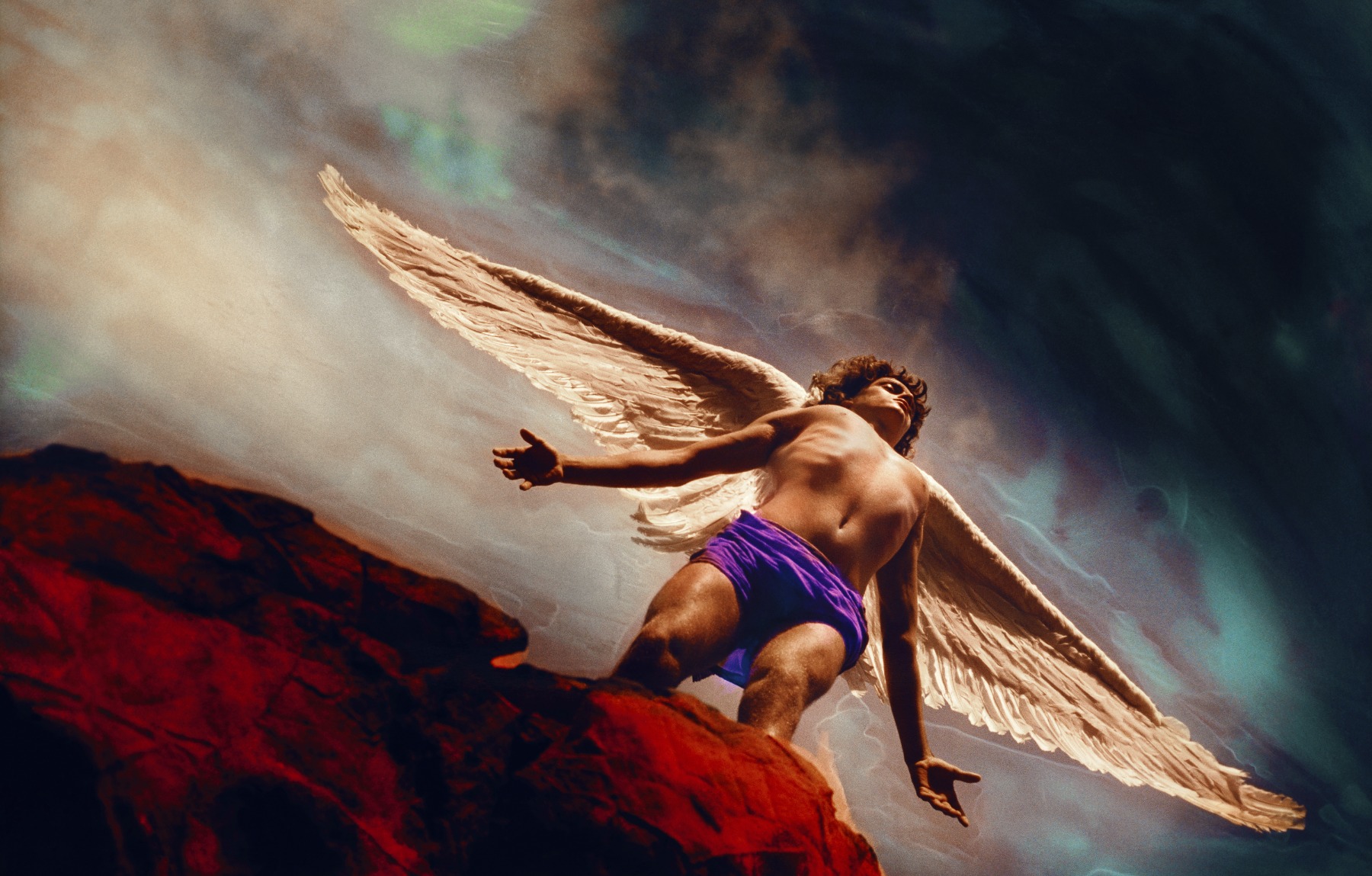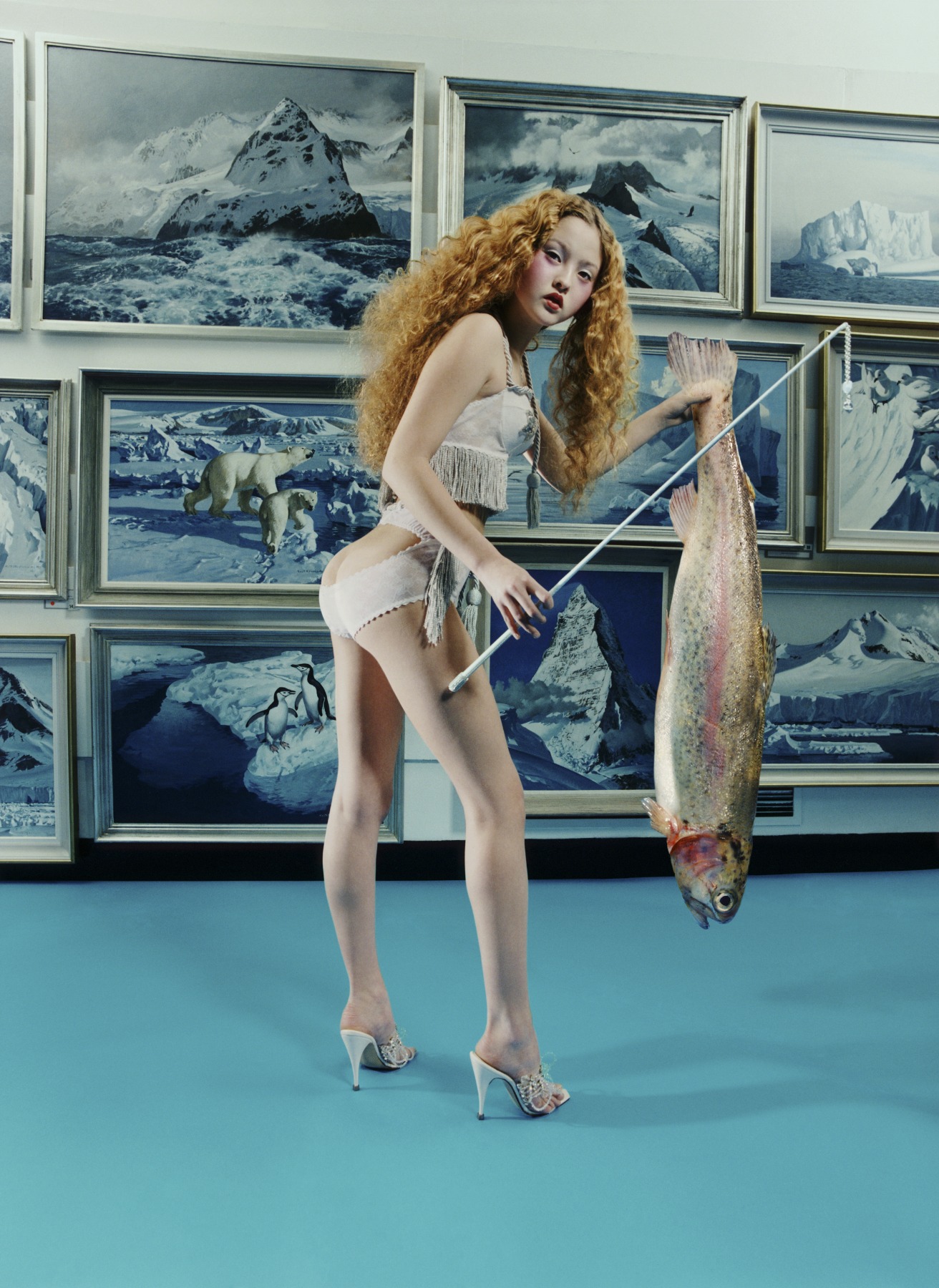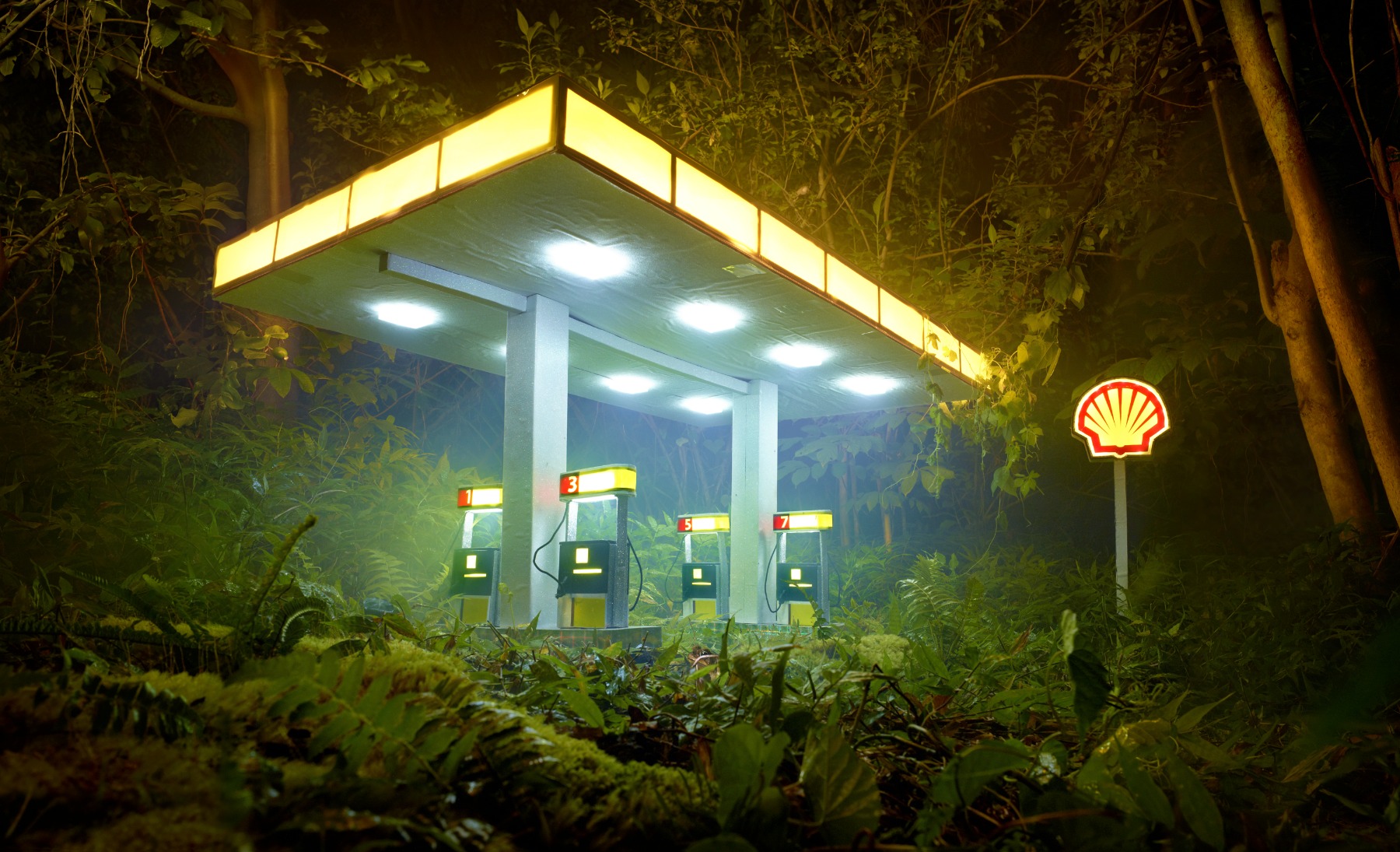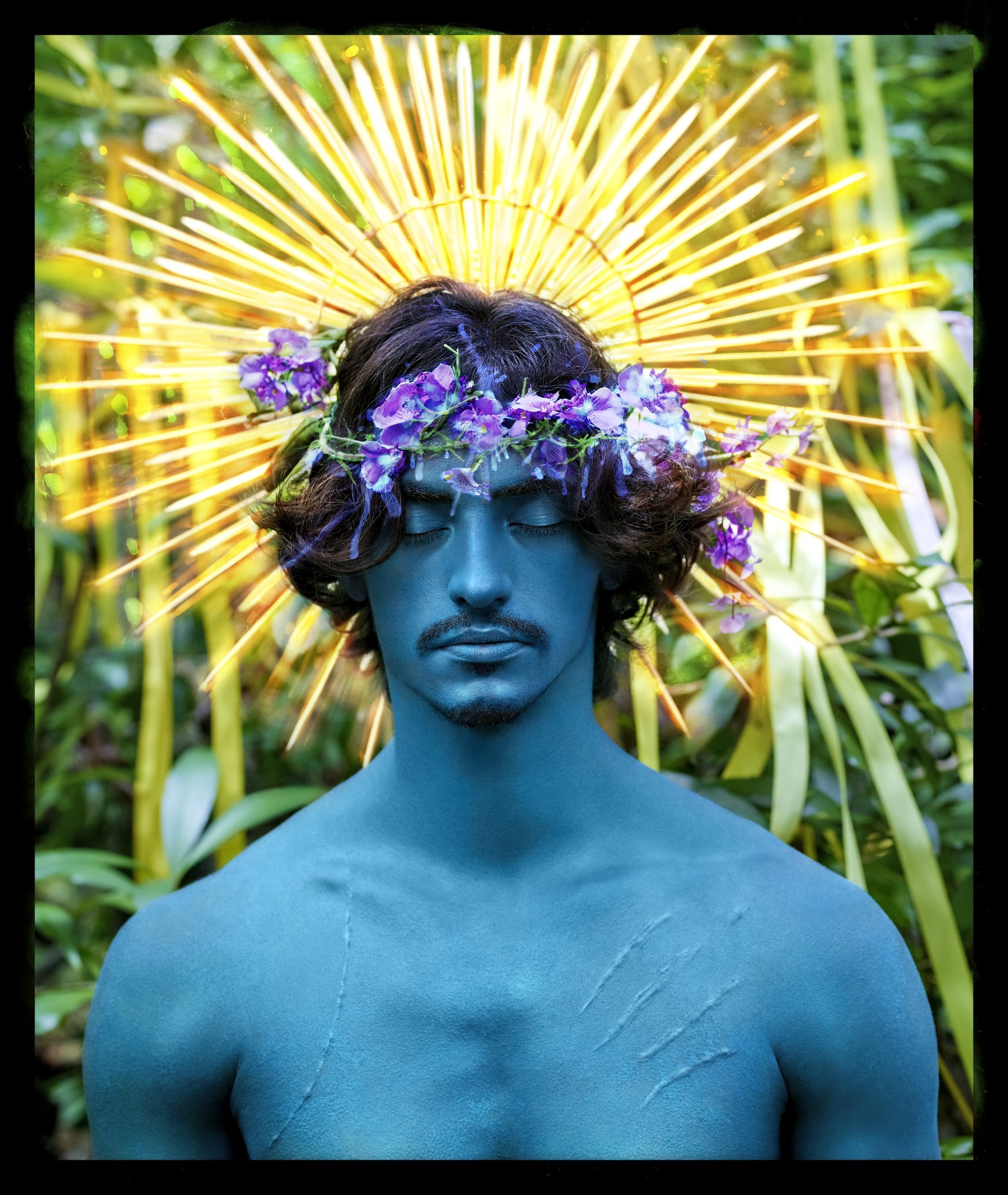
The Time Is Now
An interview with American artist David LaChapelle
American photographer David LaChapelle is one of the most iconic and provocative visual artists of our time. Known for his remarkable ability to capture the essence of contemporary culture—its light and its darkness, its beauty and its beasts—he has gained international renown for bold, surreal, and strikingly beautiful images that merge photography with conceptual art. His distinctive vision was evident early: Andy Warhol recognized it immediately and recruited him to work at Interview when he was just seventeen.
Though most widely associated with pop-cultural imagery, LaChapelle’s work has always carried political, spiritual, and religious currents. His artistic consciousness was shaped by the AIDS crisis and the loss of many friends and contemporaries. As he recalls in this interview, he was convinced he would die young as well: “During the AIDS crisis, I just assumed I had contracted AIDS — all my friends were dying, so why wouldn’t I have it too?”
Born in Connecticut in 1963, LaChapelle attended the North Carolina School of the Arts, where he initially studied painting. Early on, he developed an analogue technique of hand-painting negatives to create luminous, otherworldly color.
Through his mastery of color, inventive compositions, and theatrical narratives, LaChapelle expanded the boundaries of photography. His tableaux, portraits, and still lifes challenged traditional approaches, and his work quickly gained international attention. In 1997, The New York Times noted that “LaChapelle is certain to influence the work of a new generation… in the same way that Mr. Avedon pioneered so much of what is familiar today.”
In the decades that followed, he became one of the most widely published photographers in the world, producing landmark books such as LaChapelle Land (1996), Hotel LaChapelle (1999), Heaven to Hell (2006), Lost & Found, and Good News (2017). His practice expanded into music videos, film, and stage projects; his documentary Rize (2005) was released theatrically in seventeen countries. Many of his images—both still and moving—have become defining visual archetypes of 21st-century culture.
LaChapelle has photographed many of the most recognizable figures in film, music, art, politics, and sports, among them Aaliyah, Amy Winehouse, Andy Warhol, Angelina Jolie, Cher, David Bowie, Elizabeth Taylor, Elton John, Eminem, Hillary Clinton, Janet Jackson, Kanye West, Kim Kardashian, Madonna, Naomi Campbell, Nicki Minaj, Snoop Dogg, Tupac Shakur, and Whitney Houston.
In 2023, he received the “Lorenzo il Magnifico” Lifetime Achievement Award at the XIV Florence Biennale. Over the past forty years, his work has been exhibited in leading museums worldwide, including the National Portrait Gallery (London), Musée de la Monnaie (Paris), Barbican Centre (London), Victoria and Albert Museum (London), Tel Aviv Museum of Art, Musée d’Orsay (Paris), Palazzo delle Esposizioni (Rome), Palazzo Reale (Milan), Casa dei Tre Oci (Venice), MUDEC (Milan), Fotografiska (New York), and the North Carolina Museum of Art.
This fall, VISU Contemporary in Miami will present Vanishing Act, an expansive exhibition curated by Bruce Halpryn, owner and curator of the gallery. On view from November 29, 2025, through January 31, 2026, it will feature more than thirty significant photographs, including the world premiere of nine LaChapelle's new works, marking it as one of the standout events of Miami Art Week.
Proving its growing significance in the cultural landscape, VISU Contemporary — a young gallery founded in 2022 — has quickly become a dynamic force in South Beach, championing artists who challenge form and narrative, and offering a platform where bold voices in photography, sculpture, painting, and new media converge.
Vanishing Act arrives at a moment of global uncertainty and cultural introspection. With his singular ability to merge spectacle and intimacy, LaChapelle offers a meditation on a world in flux—where beauty meets crisis and spirituality finds space within chaos. The exhibition reflects on what we have built, what has disappeared, and what remains sacred.
Ahead of the opening, Arterritory.com spoke with the artist. This conversation offers a unique insight into LaChapelle’s worldview—his sense of urgency, his belief in beauty as a spiritual force, and his conviction that even in a moment when “the world has AIDS right now,” there is still room for beauty and hope.
David LaChapelle. Tower of Babel. 2024
The title of your upcoming exhibition is Vanishing Act. Is it a metaphor for the state of the world we’re living in right now?
Um, yeah, I believe it is. There are a lot of things. I think we’re seeing a lot of great change. Everyone kind of feels that things are different now in a way they haven’t been in other chapters of our lives. If you’ve lived long enough, you can sense that there’s something unique about this new chapter we’re in — it feels precarious.
You know, I just remember certain things — and not to specifically point only to the climate — but, for example, snorkeling off the coast of Culebra, this little island in Puerto Rico. For the first time, when I was in my twenties, I saw a living coral reef, and I cried because it was so beautiful. The fish were swimming all around me — oh my God, it was like a whole world. I didn’t expect it; I didn’t even know there was a coral reef in that area. It was a very deserted part of the island. I was there alone with a friend, and I happened to go swimming. I always wear goggles when I swim, and when I put my head in the water, I saw this incredible explosion of color — it brought tears to my eyes.
It’s been so long since I’ve seen a living coral reef. And that’s just one example — not a small one, but one of many. I want to be grateful for the things that are still here: the love, the beauty, the kindness, the warmth. I want to live in gratitude, not in a state of mourning for what’s gone, or stuck in that sad cycle of thinking about how things used to be. Because there is still so much beauty here.
Especially in my art — if I have a choice to create something, I want to create something full of light and love. I don’t want to make things that are confusing or that add to the confusion or darkness, or that just mirror it. I want to be a prism — to turn that light into something beautiful. As artists, we have a choice, and I want to choose beauty as my language, the vocabulary I use. Whatever I want to say or express, I want to use beauty in those images to touch people.
David LaChapelle. Early Fall. 2008-2011
Your work is deeply connected to emotional states. And I was thinking — when we consider the full range of human emotions, the uplifting ones, like joy and happiness, often seem to be in the minority, both in life and in art. Why do you think beauty and light are so much harder to capture than pain or sorrow in art?
Because, you know, someone working in joy or happiness isn’t necessarily more joyful or happy than someone else. It just means they’re choosing not to dwell in the darkness — they want to create something better, somewhere better.
One of my favorite artists is Sister Corita Kent. She was a Catholic nun who became an artist in the 1960s. Andy Warhol loved her — she was even on the cover of Newsweek in 1967. Her work is so joyful and explosive. She used silkscreen, too, and would take everyday objects and find the sacred, the holy, within them. When you go to her exhibitions, it’s just this explosion of joy. But I also know she suffered greatly. She was eventually forced out of the church because she was getting, I guess, too much attention, and they didn’t understand a lot of what she was doing.
Still, her work radiates joy. Even though she was going through her own struggles — like we all do — she chose to create with joy. And that’s what I try to do as well. You know, I might feel a certain way — this year has been a little hard — but I still want to create from places of love and beauty. Because there’s already so much darkness and sadness in the world — why make more of it, you know?
It makes me happy to make pictures that express joy. It makes me happy to look at them, and to share them with others. In a way, it’s like I’m making myself happier by creating something beautiful.
Especially with my recent work — I’ve been doing a lot of really figurative pieces, seeing bodies in a beautiful, almost Renaissance way, rather than through an objectified or sexual lens. The nude figure, in our contemporary moment, often gets read as something erotic or tied to sex. But when I use the figure, it’s more in the spirit of what Michelangelo said — “The beauty of man is the proof of God.”
That’s what I like to think about when I photograph people and their bodies. We’re part of nature, part of God’s creation. There’s nothing about the body that’s shameful or unholy unless we make it that way. We’re God’s creation too — just like the flowers.
David LaChapelle. Rebirth of Venus. 2009
You were always very connected to the spiritual side. Is art spiritual in its essence?
To me, it is — but I can’t speak for other artists. I think people work from all kinds of different mindsets and motivations. But for myself, I’m motivated by the spiritual, even though I also work in the secular world and create works connected to pop culture.
For a long time, I didn’t really understand how those two worlds connected. I felt very divided — like there was the secular work, and then there was the spiritual work, and I didn’t see the bridge between them. Then I started noticing that my exhibitions, especially, were crowded with young people. Artist friends would ask me, “How do you get so many young people to your shows?” And I realized it was because they knew my work with pop stars — Lady Gaga, David Bowie, Whitney Houston, whoever it was.
They came to see the images they recognized, but once they were there — in the gallery or museum — they also saw these other works that aren’t on Instagram, the ones about the Holy Family, or that are more spiritual or religious in nature. And that’s not really a trendy thing in contemporary art. It’s not what sells, it’s not what people are necessarily looking for. But I make it anyway, because that’s what’s in my heart.
I’m lucky that my career allows me to make those kinds of pictures without worrying about what will sell. I can create the images I love, while the other kinds of work I do — the more commercial or pop-cultural ones — keep the studio alive and vital. It keeps me grounded, with one foot in the world and one foot in my art. That balance keeps the energy here lively.
Because if I only made my personal, spiritual artwork, I’d kind of be cloistered — and I don’t want that. I want to be part of the world. You know, like that biblical quote: “In the world, but not of it.”
David LaChapelle. A New World. 2015
But do you believe that an artwork also has a soul?
I think an artist can put their soul into the work. I believe an artist can pour their soul, heart, love, and energy into a piece of art. But I don’t think the artwork itself has a soul — I think only human beings have souls.
If you compare the feeling in the world today with that of the 1980s, when the world experienced the AIDS crisis, are there similarities in how we, as human beings, deal with crisis?
It’s funny you ask that, because when I was a kid during the AIDS crisis, I just assumed I had contracted AIDS — all my friends were dying, so why wouldn’t I have it too? This was before there was even a name for it, or a test, or any real understanding of what it was. There was such an urgency in my work back then. I wanted to leave something behind — to give the world a gift, a reason for my being alive. I didn’t feel like I had much time.
And I feel that same urgency again now — that need to get new pictures out into the world. Not because I think the world is about to end, although honestly, who knows, with everything going on — the politics, the wars, the rumors of wars. But I feel this urgency to put good things out there.
You know, when the most-watched thing on Netflix, the most downloaded show ever, is Jeffrey Dahmer — about a serial killer — it says something. People are obsessed with dark things, with darkness in general. As a society, we’re so careful about what we eat — what’s healthy, what kind of oils are good or bad, whether we’re vegetarian or carnivore — but when it comes to what we consume with our eyes, people seem to care so much less.
The films we watch, the music we listen to — those things are just as important to the health of our spirit and our mind as food is to the health of our bodies. We’re so concerned about what we put into our bodies, but we also need to think about what we take in as viewers, as audiences.
That’s why I try to limit how much news I watch. I don’t watch horror movies or anything like that. I just feel like it’s wrong to celebrate death, or to use death and torture and killing as entertainment. There’s already so much of that in real life — why would I want to see it fictionalized? I’m kind of dumbfounded that so many talented artists and filmmakers pour their energy into making these dark, nihilistic films — a million different ways to kill people. I don’t understand how you can sleep at night making that kind of work.
People are obsessed with serial killers now — but couldn’t we be obsessed with other things? If you look at the popular culture of the 1960s, people were singing about joy, peace, love — things that might seem corny or trite to some now, but they were sincere. Those songs were full of light and soul — like the art of Stevie Wonder. His work was so full of beauty and joy, and still acknowledged the struggles of life without being consumed by them.
And that’s how I want to live and create — not by hiding from the darkness, but by refusing to dwell in it.
David LaChapelle. Fly on My Sweet Angel Fly on to the Sky. 1985
You mentioned this overload of information — of visual information — and I think we’ve also forgotten how to look, how to look deeply, and how to create a moment of silence between ourselves and what we’re looking at. What’s your suggestion? How can we get someone to stop and really look carefully at something — at a work of art — instead of just passing by and taking an Instagram picture? Also, how do you approach that in your own work?
It’s definitely more challenging now to make people stop and spend time really looking at a piece. It’s harder for artists to create work that’s compelling enough to make someone pause. Our attention spans are shorter, and we’re so used to scrolling quickly through images.
That’s why I put extra care into my pictures — to make them more compelling through beauty, and by putting a lot of thought and intention into each one. As a result, I’m making fewer pictures now, but putting more energy into every single one. I think about each image more carefully and spend much more time with it.
Because there are already so many images in the world, I feel that making fewer but more thoughtful works gives them more power. I want them to be so considered, so crafted, that people will stop and really look — and beauty is part of that.
People tend to turn away quickly from what’s ugly, or confusing, or what they don’t understand. So I want to be very clear in my pictures. I want clarity — I want to know what it is I’m trying to communicate, first of all. Then I think about how to say that in an image, and how another person might perceive it.
So I think of all those things. And for me, beauty is the language that gets people to stay longer, to contemplate an image, and to maybe feel something deeper.
David LaChapelle. Devon Aoki: Fish Stick. 1998
One of the new works premiering at the exhibition is titled Will the World End in Fire, Will the World End in Ice. Could you elaborate a little on it? Does it suggest that the end is unstoppable, or does it mean something entirely different?
The work shows a cruise ship with all its lights on — but it’s frozen in the ice. So instead of the ice melting, everything is stopped in time.
There are all these things happening in the world, but we’re kind of going about life as if everything is normal. We’re so adaptable. We’ve had all these fires, so many traumatic events, and yet we just keep moving forward as though it’s all the same — but it’s not. Things have really changed. It’s almost like playing the flute while Rome burns — or the violin — just continuing on with business as usual.
I think this is a moment when we really have to look inward and ask ourselves if we’re living right. It’s almost as if the world has been diagnosed with a terminal disease. It’s like the world has AIDS right now. When someone had AIDS, the doctors would treat one illness, and then another would appear — they’d battle that one, and then another would come. That’s what it feels like now: we put out one fire, and another starts somewhere else. One crisis ends, and another begins.
When people are faced with death, they tend to forget about material things. They start to look inward, to examine their lives, to realize that possessions and ambitions no longer hold meaning — that what matters is what’s inside, what kind of people we are.
And I think we all have that opportunity now — to make the changes we want to see in ourselves. There’s an urgency to do that. This moment is a reminder, almost a warning: now is the time. Now’s the time to change, to become who we want to be.
David LaChapelle. Land Scape: Luna Park. 2013
You left Los Angeles in 2006 to live in Maui, Hawaii. On the land you bought, you even built your own church. Did that help you find balance in life?
I’ve always loved being in nature. I’ve spent about ten years now back in Los Angeles, since that’s where my studio is — but even here, my house has a backyard filled with trees. It’s like being in a forest. When you’re back there, you’d never know you’re in the middle of Hollywood — all you see is trees and greenery.
Nature is very healing for me. It’s so important to have that connection — to be in nature, to bathe myself in the green of the forest, the trees, and the plants. It feels very human. It grounds me. It makes me happy.
I love trees. I can’t go anywhere that doesn’t have trees. I could never go on a cruise ship — there are no trees! (laughs)
David LaChapelle. Gas Shell. 2012
There is an iconic self-portrait of you titled Self-Portrait as a House. How might these rooms look now? Have they changed?
I think I’m still dealing with a lot of the same things. You know, you work on yourself, you try not to repeat the same mistakes you made before, the ones you thought you’d fixed a long time ago — and then you get frustrated, even mad at yourself. We have to be gentle with ourselves. We just have to try our best to become better. But yeah, I can be very hard on myself. Sometimes I fall back and make the same mistakes I made earlier.
But I think life’s a journey, and as long as we really try our best to live right — whatever that means to each of us — it matters. I still stumble sometimes, still make the same mistakes, but it’s getting better.
It’s really about finding balance in my life. There was a time when I worked so hard that I didn’t have time to think or reflect — I was just working constantly. I never finished high school, so I always had this fear, this feeling that I had to keep working nonstop, otherwise I’d fall behind or fail somehow.
Now I’m much more relaxed about it. I don’t worry as much about work or money or those kinds of things. I just have faith and do the best I can — try to be a good friend, a good person, and make good art.
David LaChapelle. Photo: ©Thomas Canet
You once said that you pray for inspiration. Why is prayer important to you, and how has it influenced your attitude toward life?
I’ve been praying since I was a little child — since I was very young. I feel that my prayers are answered. I feel they’re heard. I pray for inspiration, to make good images, and I pray for other people. I pray all the time.
Giving thanks is a form of prayer. A song can be a prayer. A work of art can be a prayer too — if it’s made with the right intention. But yes, I also formally pray every day. And as much as I can, I try to give thanks, to stay grateful.
It really comes back to where we started — being grateful for all the good things that are still here: for the people who are still here, for the joy, the love, and all the beauty that’s still present in the world, instead of longing only for the things that are gone.
David LaChapelle. Behold. 2016
That means the exhibition can also be a kind of prayer, in a way.
In a way, yes — for sure. When you dedicate something to God, it’s a prayer. In Hawaii, for example, people take a stone and wrap it in a sacred leaf — a ti leaf — and that’s their prayer. Sometimes you’ll go to a waterfall and see a little stone wrapped in a ti leaf, and you know that’s someone’s prayer. It’s so beautiful — so symbolic.
Thank you very much.
Title image: David LaChapelle. Photo: ©Thomas Canet
